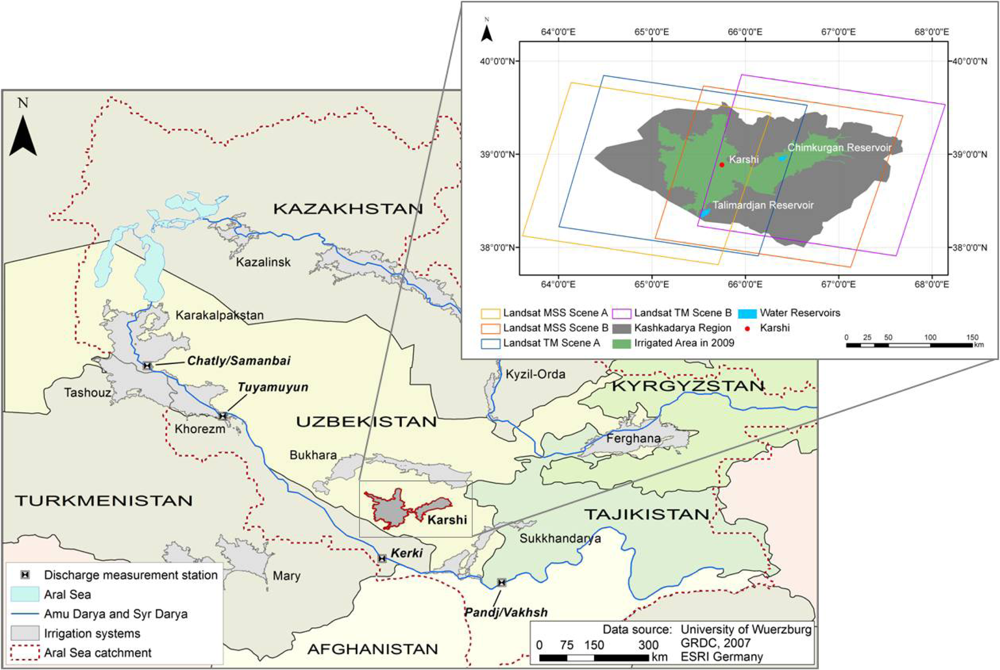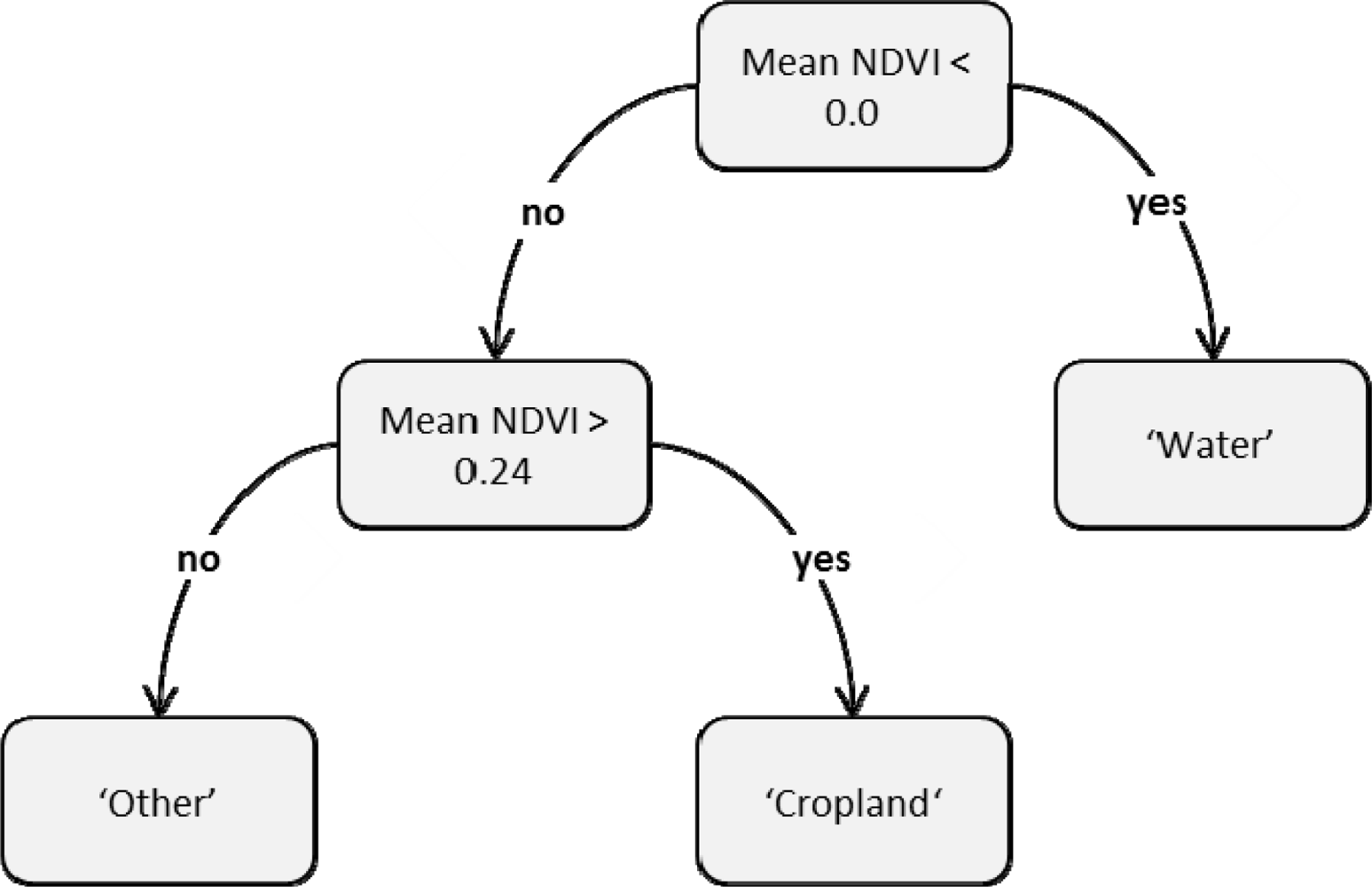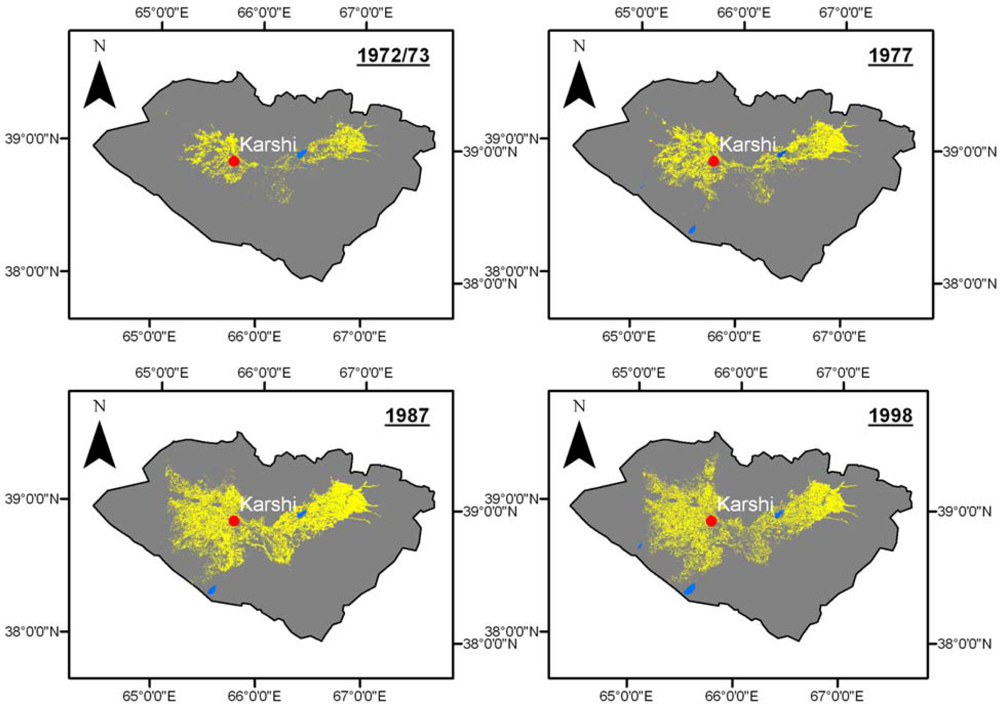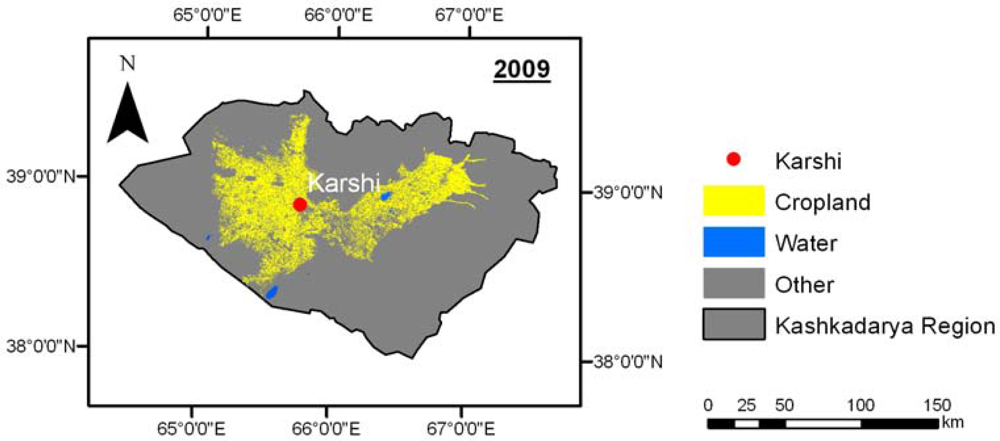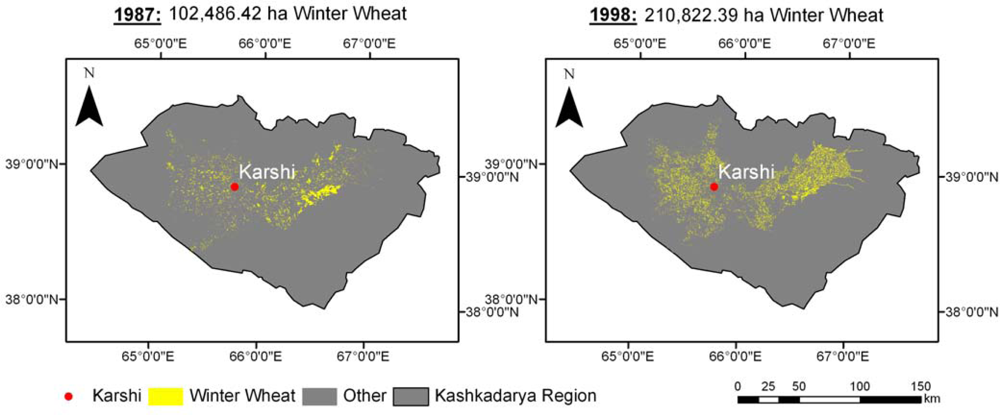1. Introduction
Irrigation agriculture and cotton cultivation has a long tradition in the Aral Sea Basin in Central Asia. However, in the second half of the 20th century the Soviet Union (SU) intensified the agricultural systems through a large-scale expansion of irrigation and drainage infrastructure [
1]. With the aim of meeting the demands of a growing population and strengthening the national economy, the overall area of irrigated land in the Aral Sea Basin was rapidly expanded from 4.51 to 7.99 million ha between 1960 and 2000 [
2]. Traditional crops were replaced and crop rotations were sacrificed for monocultures, such as the cash crop cotton in the socialistic republic of Uzbekistan. Melioration practices and the provision of major production factors (water, fertilizers, chemicals) enabled the farming population, who was partly resettled from other parts of the SU bloc, to cultivate even the steppe regions, but under extremely dry continental climatic conditions [
3].
Triggered by its historical development, the former Soviet republic Uzbekistan, Central Asia, became the sixth largest cotton producer worldwide [
4]. Since the entire cotton chain in the country accounts for 35% of the national GDP, 60% of foreign exchange receipts, and 45% of employment [
5], this illustrates the dependency of the country on a sustainable land use for cotton production. But the situation in the agricultural production systems of Uzbekistan has become alarming because severe land degradation and ill-managed water resources endanger the livelihoods of the rural population and the welfare of the country given its high path dependency on cotton. Excessive use of irrigation water, deteriorating irrigation canals, and missing or malfunctioning drainage systems have already increased groundwater levels and accelerated secondary salinization since Soviet times [
3]. About 60% of the irrigated land in Uzbekistan is reportedly already affected by medium to high soil salinity, which can reduce potential yields by 30–40% to 50–60%, respectively [
6].
The irrigation expansion initiated during the SU era caused manifold environmental challenges. The construction of new water reservoirs and irrigation canals interfered strongly with the natural water balance of which the demise of the Aral Sea is probably the most well-known example. Until 2009, the Aral Sea for instance lost 92% of its water resources available in 1960 [
7]. A loss of biodiversity was recorded along the rivers and in their delta regions, where valuable wetlands and ecosystems disappeared due to the now regular occurring, man-made droughts [
3,
6]. Furthermore, the numerous desert sinks, which have been filled with highly saline drainage water, are further evidence for the ongoing environmental damages. Following independence in 1991, various reforms have been initiated to arrest or even reverse the ongoing trend of resources degradation in Uzbekistan. Despite the programs launched to support these reforms, limited impact has been seen on the ground thus far. These programs could benefit from both knowledge of historical processes and up-to-date, reliable and comprehensive information to support current decision-making processes.
Knowledge and awareness about the implementation of previous decisions for intensifying irrigated agricultural production may qualify current decision makers for an improved understanding of the impacts of irrigation on different ecological settings. Latest research results underline for instance that a further expansion of irrigation and drainage networks in Uzbekistan are likely to occur in case of continuing recently initiated reforms [
8]. However, due to geological reasons, the majority of virgin land shares in the country exploited for irrigated agriculture after 1950 was already saline [
9] whilst similar conditions can be found on the presently envisaged expansion areas. Thus, monitoring and understanding the development of land conversion in a spatially explicit way is essential for future decision-making. For instance, by combining frequent observations of the cropland area with information on changing soil properties, soil degradation processes can be understood better in time and space. Spatially explicit information on land use changes is helpful for assessing the necessary resources suitable for maintaining the agricultural production, e.g., calculations of demands for infrastructure and production inputs, or simply for prioritizing canal rehabilitation plans. The latter is especially important as water losses from irrigation and drainage networks in the Aral Sea Basin amount to about 40 km
3 annually [
10] meanwhile the water demands for agricultural production in Uzbekistan are likely to increase [
8].
Multi-temporal remote sensing is widely recognized as a powerful tool for land surface mapping and change detection, which includes mapping of irrigated areas [
11,
12]. Frequently moderate-resolution sensors such as MODIS or SPOT Vegetation have been used for mapping irrigated croplands (among others [
12–
15]). These sensors cover extensive areas over long periods thus permitting to contribute to global area coverage even in intervals of several days. Similarly, a wealth of information exist on numerous approaches used for mapping agricultural area or crops through high-resolution data recorded by sensors such as Landsat, although only few studies applied multi-annual time series of Landsat data. Martinez-Casanovas
et al.[
16] analyzed for instance spatial cropping patterns in a small-scale irrigation system in Spain over eight years (1993–2000), however, with an incomplete sequence of these years. Maxwell
et al.[
17] used a complete set of annual Landsat time series for the period 1994 to 2010 (two to eleven scenes per year) with the purpose of mapping permanent-cropped land in several counties of the US. One innovative multi-sensor approach was presented by Thenkabail and Wu [
18], who combined the high geometric resolution of Landsat and the phenological details of MODIS time series in decision tree classifications for mapping cropland in Tajikistan in 2005 and 2010. However, even though the Landsat archives of NASA have been made accessible, applications of Landsat time series for mapping the development of irrigation agriculture over longer time periods have not been reported yet.
This study aims at a method that enables reconstructing the spatio-temporal development of irrigation systems between 1972 and 2009 using satellite remote sensing for the Kashkadarya Province of Uzbekistan, Central Asia. Sequences of different Landsat satellite data were used to generate objective maps of historical land use changes with a focus on the laminar expansion and the intensification of agricultural land use, which is defined here as the densification of agriculture per area and agricultural usage of different soil types in the study region. Our research spans the period from the installation of a large-scale irrigation infrastructure in the Kashkadarya Province during the SU era starting in the early-mid-1970s, the intensification of winter wheat production following the independency of Uzbekistan in 1991, till today, where a restructuring of the irrigation systems is envisaged. The period under investigation includes the openings of the Karshi Pumping Cascade in 1973 and the Talimardjan Water Reservoir in 1975/76. These were the most relevant infrastructural steps towards expansion and intensification of the irrigation systems in the study region.
2. Study Area
The Kashkadarya Province is located in south of Uzbekistan. The eastern part of the Kashkadarya Province consists of the foothills of Pamir Mountains from where the Kashkadarya River enters the flat Karshi Steppe, which is the western part of this province. The climate of the region is continental with hot and long summers, and short winters with little snow [
19]. The long-term annual average temperature in the region is 13.5 °C. Precipitation mainly occurs during the winter months showing an increasing trend from the steppe to the mountains and averages at 355 mm per year [
20].
Given the characteristics of precipitation and weather, agriculture in the Kashkadarya Province relies on supplemental irrigation especially in summer. From the mid-1960s onwards this province became a large-scale irrigation area. The irrigation network to be installed was designed for supplying more than 500,000 ha of irrigation land with water. This district became one of the major cotton production areas of the former SU and received massive amounts of resources for maintaining the productive potential of its irrigated land. Therefore, the irrigation system of the province was divided into two planning zones (PZ). The Kashkadarya PZ, located upstream, is completely supplied with irrigation water from the Kashkadarya Basin. The Karshi PZ on the other hand is by 90% irrigated with water from the Amudarya, the other 10% originate from the Kashkadarya River, in particular the Chimkurgan Water Reservoir in the east of the Kashkadarya Province (
Figure 1) [
21]. The Karshi Steppe (PZ) is not directly located at the banks of the Amudarya. Hence the river water is conveyed over a distance of 78 km via the Karshi Main Canal (design capacity 175 m
3/s) and the Karshi Pumping Cascade (KPC), which was constructed in 1973. Seven pumping stations lift water 159 m from the Amudarya into the Talimardjan Water Reservoir from where a maximum water amount of 360 m
3/s can be released [
22]. Beside irrigation water, the reservoir also provides drinking water for the inhabitants of the Karshi PZ. Today, the efficiency of the pumping stations and canals in the KPC has been declined, which has been assessed as one of the major causes for the reduced productivity of the Karshi PZ [
5,
21]. Thus, adequate land and water management decisions are required in this highly drought-prone basin, especially under increasing climate variability, which predicts lower water supply to the lowlands of Central Asia including the Kashkadarya Province of Uzbekistan [
23].
Although cotton is the main crop in both PZs, the Kashkadarya Province has been designated an important role in the wheat production of Uzbekistan following independence in 1991. In comparison to other Uzbek provinces, the production of both strategic crops was reportedly much lower in the Kashkadarya planning zones during 1991–2005 [
24]. Furthermore, rice, corn, vegetables, orchards and gardens are reported for this region [
17].
The irrigated areas are nowadays situated in desert and sierozem soil formation zones [
25]. Prior to the introduction of the large-scale irrigation networks and intensive crop cultivations schemes in 1960, the natural soil conditions were poor. The soils in the Karshi steppes are mainly solonchaks on aeolian and sandy depositions and takyric salic solonetz. In the center, typical and light sierozems are found. At the foothills of the Pamir Mountains, dark sierozems and brown soils dominate [
26]. Due to intensive irrigation activities since the 1960s and the subsequent rise in ground water tables, the zonal features of the soils have changed and the hydromorphic features have increased [
25].
5. Conclusions
A significant laminar growth of cultivated land and an intensification of the cultivation in the Kashkadarya Province of Uzbekistan from 134,775 ha in 1972/73 to 469,685 ha in 2009 were shown in this study. Multi-temporal Landsat MSS and TM available for five time steps (1972/73, 1977, 1987, 1998, and 2009) enabled the monitoring of these land use changes initiated by the construction of the Talimardjan Water Reservoir in the early 1970s. Also a duplication of wheat acreage from 102,486 ha in 1987 to 201,822 ha in 1998 was recorded, which is a result of land use policy in Uzbekistan, where winter wheat was increased after independency in 1991. Furthermore, overlaying the classification results with historical soil maps showed the temporal sequence, in which different soils were utilized for irrigation, in a spatially explicit way. The findings illustrate the strategies used but also the magnitude of the degradation risks, which apparently had been accepted by the Soviet policy makers in the Kashkadarya region during the expansion period and can also be supportive for the implementation of measures of improvements, for instance the prioritization of canal rehabilitation plans.
Knowledge-based decision trees based on Landsat scale proved to be suitable for mapping cropland of agricultural landscape within desert and steppe zones. However, even in less complex landscapes like the Karshi planning zone in the Kashkadarya system, the inclusion of ancillary information like high resolution data and a digital elevation model are required for increasing the accuracy of the results. An integration of modern field-based classification techniques can be also concluded beneficial for such long-term Landsat cropland monitoring approaches as presented.
The utilization of the Landsat Archives in the Kashkadarya Province of Uzbekistan is the first application of mapping cropland development in Central Asia over the past forty years in a spatially explicit way. It is very likely that the presented approach can be transferred to all 8 Mio ha of irrigated land in this region, because numerous Landsat MSS and TM data are available in the archives due to the extremely good atmospheric conditions in the lowlands of the Aral Sea Basin. In this potential way forward, the knowledge bases need to be adjusted to the cropping patterns of the other irrigation districts and the time steps for which data records are present within the cropping season. The method can be principally used for creating reliable and transparent databases and for further studies to design land and water management strategies in the Aral Sea Basin and similar problems in arid ecosystems worldwide.
